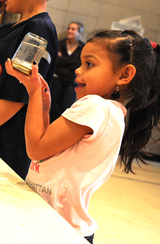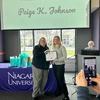Their teaching tools, from teeter-totters to balance beams to falling objects, are anything but high-tech, but these students don’t seem to mind. The students are enrollees of the Boys & Girls Club in Dunkirk, and their teachers — prospective childhood education students from SUNY Fredonia, are bringing science to life for them in a fun and tangible way.
Students enrolled in the Science for Elementary Educators Lab, hosted a “Science Showcase” for the Boys & Girls Club last week, featuring seven learning stations to engage youngsters, ages six to 13, in actual science experiments.
And if the smiles are any indication, the showcase was a win-win for both age groups.
|
Below, Lili Parker, age 7, observes a lesson in the laws of gravitation. More photos>> Roger Coda photos. |
For 90 minutes, 28 university students demonstrated science principles at learning stations to nearly two-dozen youngsters. Everything was hands-on, so the children were actively engaged in applying the law of gravity and other physics principles.
“They really love doing all the projects,” said Kim Killion, administrative assistant at the club. “As soon as we say the science fair is coming, they know exactly what we are talking about. They ask every day until it’s here.”
A simple teeter-totter demonstrated how two objects of different weight — in this case, a tiny seven-year-old and a lanky college freshman — could be evenly balanced on a beam when the much heavier student is moved closer to the fulcrum, or the balance beam’s resting point. Children also learned the same physics lesson by placing various weights on table-top scales. “They really loved playing with the scales,” Weborg-Benson noted.
Children also learned about another Sir Isaac Newton law — that acceleration equals force over mass, by observing how objects of different weight fall at the same rate, as long as they are of similar shape. They dropped pairs of common objects, such as real and plastic golf balls, and plastic bottles, either empty or full of water, to witness gravitational acceleration remaining constant, regardless of weight.
“As long as they are shaped the same, they fall at the same rate,” Weborg-Benson explained.
Simple levers or catapults were positioned at one end of the gym so children could launch objects to knock down paper cups.
Another station demonstrated the center of gravity with cut-out paper clowns, with pennies taped to their hands, which children could balance on the rim of a cup. The clowns were positioned as if they were standing on their hands, which were lower than their nose, which served as the center or balance point.
Children were able to color their own paper clowns and take them home so they could present the experiment to their own families.
The Science Showcase is conducted every semester at the Boys & Girls Club, but the experiments are never the same. “We try to do something different every time,” Weborg-Benson explained. This science lab course is recommended to child education majors because it is interdisciplinary, encompassing physics, earth science, chemistry and biology.
Members of SUNY Fredonia’s student chapter of the National Science Teachers Association also participated in the event.
The Boys & Girls Club is an ideal venue to provide students with real-world experience working with children. The Science Showcase also gives prospective teachers ideas for science experiments that they can use in their own classrooms, Weborg-Benson noted.





